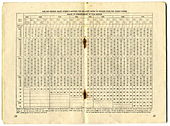- Demobilization of the British Armed Forces after World War II
-
At the end of World War II, there were approximately five million service-men and -women in the British armed forces.[1] The demobilization and reassimilation of this vast force back into civilian life was one of the first and greatest challenges facing the postwar British government.
Contents
Demobilization plan
The wartime Minister of Labour and National Service, Ernest Bevin, was the chief architect of the demobilization plan, which was unveiled to the public on September 22, 1944. Most service-men and -women were to be released from the armed forces according to their 'age-and-service number,' which as its name suggests was calculated from their age and the months they had served in uniform. A small number of so-called 'key men' whose occupational skills were vital to postwar reconstruction were to be released ahead of their turn. Married women and men aged fifty or more were also given immediate priority.[2]
Release process
The release process began on June 18, 1945, about six weeks after V-E Day.[3] During the next eighteen months about 4.3 million men and women returned to 'civvy street'.[4] The process was not without controversy. Frustration at the allegedly slow pace of release led to a number of disciplinary incidents in all branches of the armed services in the winter of 1945-6, most famously the so-called RAF 'strikes' in India and South East Asia.
Personal challenges
Aside from the institutional problems of release, returning service-men and -women faced all kinds of personal challenges on their return to civilian life. Britain had undergone six years of bombardment and blockade, and there was a shortage of many of the basic essentials of living, including food, clothing, and housing. Husbands and wives also had to adjust to living together again after many years apart. One indicator of the social problems this caused was the postwar divorce rate; over 60,000 applications were processed in 1947 alone, a figure that would not be reached again until the 1960s.[5]
Notes
See also
- Demobilization
- Military discharge
- Military history of the United Kingdom during World War II
- National Service (Armed Forces) Act 1939
- Royal Air Force Mutiny of 1946
- Post–World War II demobilization strikes
External links
Further reading
- Alan Allport, Demobbed: Coming Home After the Second World War, Yale University Press, 2009, ISBN 0-300-14043-6
- Barry Turner & Tony Rennell, When Daddy Came Home: How Family Life Changed Forever in 1945, Pimlico, 1995, ISBN 0-7126-7469-1
Wikimedia Foundation. 2010.

